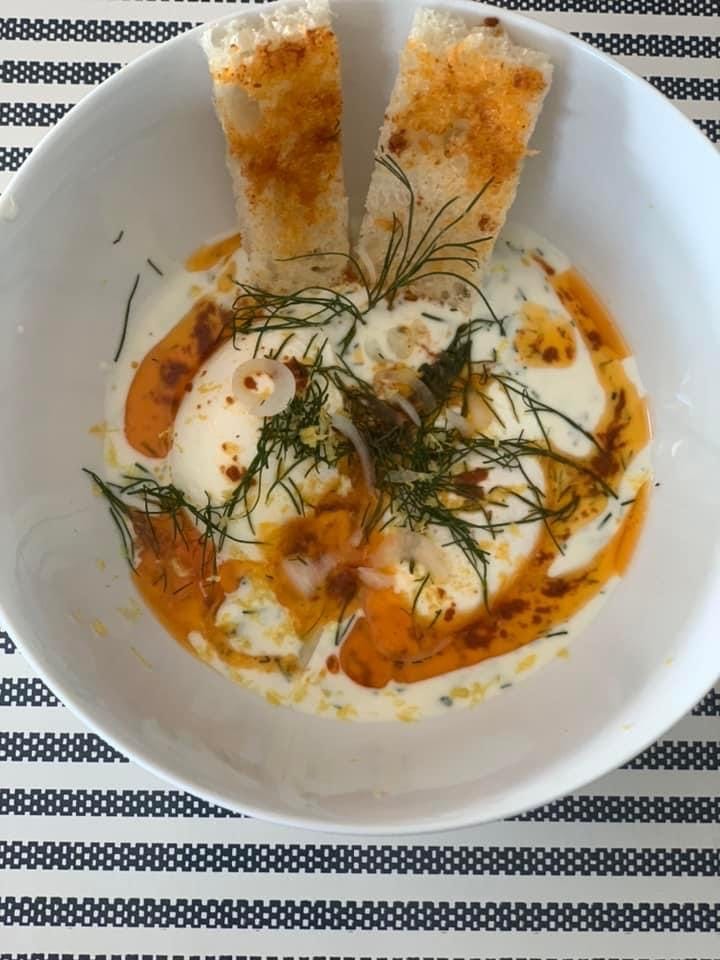In 1976, Dannon went all in on a Mad Men-style campaign. The PR mavens at Marsteller launched In Soviet Georgia flooding the public with images of Georgian and Slavic 100+ year olds. Though weathered and life worn, these ancients seemed to defy aging as they went about impossibly vigorous lives in rural mountain villages. Imagine the suggestive power as an old man eating Dannon as he sits contentedly with his doting 114-year-old mother. The voiceover telegraphs what we most long for…why not eat yogurt? It might keep us together forever?

Elixir of youth: Is there truth here that eating yogurt promotes longevity?
The promise of this milky white elixir of youth actually begins much earlier with a late 19th century Russian-born biologist of Moldavian royal ancestry named Metchnikoff ; Dannon’s execs were simply capitalizing on earlier events. Metchnikoff, a zoologist and colleague of Louis Pasteur at the Institut, was best known for his 1883 work in early cell-mediated immunology.
Keenly obsessed with death, he had noticed that Bulgarians living into their centennial years ate traditional diets rich in cultured milk. Yogurt and curdled sour dairy were staples in every home kitchen. When Metchnikoff went off to Paris in 1904 to continue his scientific inquiries, he gave an invited lecture entitled Old Age attended by the public. “Was aging simply a chronic disease caused by microbes or poisons?” he posed. He suspected longevity must be linked to lactic acid bacterial fermentation in cultured dairy. To his mind, intestinal putrefecation, our modern day conception of “inflammaging,“ caused senescence. Experiments he conducted in his Paris lab had shown that the bacterial fermentation of milk sugar to lactic acid inhibited biological detritus in the gut, and this bacterial overgrowth, he believed, drove aging.
Journalists seized hold of tangy matsoni, a soured milk cultured beverage or yahourth (yogurt) favored by rural Georgians proclaiming it to be the elixir of youth. LONG LIVE LIFE! read Le Matin. Le Figaro sent seekers to “taste the delicious Bulgarian curdled milk that the illustrious Professor Metchnikoff has recommended for suppressing the disastrous effects of old age.”
Word spread far to England and the United States. The Chicago Daily Tribune reported, “Sour Milk Is Elixir: Secret of Long Life Discovered by Prof. Metchnikoff.” By the 1920’s, sour cream and yogurt were de rigueur in every icebox. Doctors wrote yogurt prescriptions Folks in pursuit of living to 100 streamed to buy pots of yogurt boosting “soured milk” sales wildly.

Had Metchnikoff been alive today, he might have found support for his theory that bacilli inhibited pathogenic insults. Just in another form. L. acidophilus has been shown to inhibit the adherence of harmful strains of Escherichia coli and Salmonella typhimurium to the intestinal enterocyte, defending the colon at its first point of entry. Yogurt’s effects on the integrity of the intestinal lining and gut-associated immune tissue may be the root of its immune boosting activity. Through its Bulgaricus and streptococcus thermophilus bacterial strains, yogurt appears to exert immune and inflammatory protection. It seems to benefit a host of inflammatory conditions from irritable bowel syndrome, Crohn’s disease, ulcerative colitis, and rheumatoid arthritis. Its beneits seem to go beyond immunomodulation impacting metabolism as well reducing risks of chronic diseases.
Reported benefits
reduces longterm weight gain
improves insulin sensitivity
nourishes gut bacteria
improves bone health as a good source of calcium and phosphorus
Consuming as little as a 3.5 ounce serving or 2/3 of a single-serve container of unsweetened yogurt has been shown to improve heart health.
Surveying 192,564 US veterans enrolled in the Million Veteran Program, a group of researchers set out to distinguish if yogurt has unique health value compared with other low fat dairy. Yogurt over low fat milk consumption indeed predicted better blood lipids. A complement study followed 54,903 middle-aged Danish men and women to find yogurt in place of low or whole-fat milk lowered the incidence of heart attacks over 15 years.
Yogurt helps keep gut bacteria balanced.
Its small chain fatty acids, calcium, magnesium, whey protein, and vitamin D all have positive effects on insulin sensitivity.
Most lactose-intolerant individuals can consume yogurt as the bacteria in yogurt cultures can help support lactose digestion and reduce symptoms.
If you include one or two servings daily of dairy in your diet, make at least one of them yogurt or cultured dairy.
Metchnikoff felt the press sensationalized his claims. He even attempted to walk them back as the frenzy for cultured products went 19th Century “viral.” He was invested enough to drink soured milk every day. It is even purported that during the cholera epidemic he drank a cholera inoculum as a self-experiment, but he never got ill.
Fundamentally, one can argue that Metchnikoff was a futurist. The hypothesis that yogurt benefits health as a privileged food appears to prove true. Nevertheless, despite his theories published under the title The Prolongation of Life: Optimistic Studies, he succumbed to heart failure at the age of 71. Perhaps yogurt may not deliver a full century, but it does promote quality longevity—— and isn’t that your goal?
What to know
When choosing cultured dairy products, look for those that specify they are naturally fermented through the addition of lactobacilli or “active strains.” Some products labeled “probiotic” or “live” will have added Bifidobacterium and additional Lactobacillus strains after heat-processing. To meet the National Yogurt Association's criteria for “live and active culture yogurt,” the finished yogurt product must contain live Lactobacilli in amounts ≥ 108 organisms/g at the time of manufacture.
The protein content of commercial yogurt is generally higher than that of milk due to nonfat dry milk added during processing.
Greek yogurt is strained to remove the whey portion resulting in a higher protein/ gram content.
Fermentation conditions and bacterial cocktails influence the sour taste and tang which differs between cultured products as well as commercial brands- keep sampling to find the one your palate likes..
Be sure to pay attention to sugar content which can be high, particularly in low-fat flavored products.
Purchase plain or Greek yogurt and add fresh fruit, homemade compotes, nuts, and honey or maple syrup to reduce added sugars.
No Need to Limit Yogurt to the Breakfast Bar
Switch up your yogurt choices. Alternatives to yogurt include Kefir, a drinkable fermented milk popular in Eastern Europe, which makes for a great protein-packed breakfast on-the-go. Add fresh herbs and thin with water to serve as a chilled summer soup.
Skyr, a traditional Icelandic fermented product, is a little less tart and creamier than yogurt. It’s also a great choice for breakfast often topped with fruit and nuts.
Savory Uses of Yogurt Throughout the Mediterranean Basin
Try yogurt in a cooling dip. Southeast Asian cultures add garlic and cucumber to make raita to eat with kebabs, or to toss over lentils and rice or pulao,. Similarly, the Greeks, Turks, and Slavs whip up an addictive tzatziki, garlicky yogurt laced with dill, cucumbers, and herbs, to serve thick and creamy with salads, fish or vegetables. or thinned out as a soup. Mast o khiar marries 1 cup Greek yogurt, 1 Persian grated cucumber, 1 Tablespoon dried mint, with raisins and walnuts to eat with bread and grilled meats and vegetables.
Labne is a spreadable fermented yogurt cheese to use in place of cream cheese, in dips, or as an accompaniment to roasted vegetables and fish.
Labne is a great swap for cream cheese and ideal for richer dips and spreads. Typical of Middle Eastern cuisine where it originated, it is used to top dishes like shakshuka, a cumin-scented tomato and egg stew and burghul w banadoura, a tomato bulgur pilaf. Popular in North African and Indian dishes, you might find it bathing red lentils in a Yemeni breakfast soup or a Tunisian chickpea lablabli.
How I make labne at home from store bought Greek yogurt
I make labne (labneh) at home using this inexpensive kitchen "yogurt cheese" maker. It's essentially a fine sieve with a box to collect the moisture and whey that can be found inexpensively on Amazon. It also doubles as a storage container in the fridge. I strain 2 to 5 percent Greek yogurt 4 hours or overnight for best results.
Turkish Poached Eggs in Hot Garlicky Yogurt with Spinach (Cilbir)
In this dish, poached eggs are nestled into a creamy bed of yogurt infused with garlic and Turkish pul biber or Aleppo pepper flakes. It’s comfort food worthy of Sunday brunch. Vinegar is typically added to the poaching water to help the white coalesce.
4 servings
2 Tablespoons white vinegar
5 ounces baby spinach leaves, washed and drained
4 small garlic cloves, minced
2 cups plain Greek yogurt or labne, room temperature
4-8 large eggs
5 Tablespoons extra virgin olive oil
11/2 teaspoons Turkish pul biber, Aleppo pepper flakes, or red pepper flakes
1 Tablespoon unsalted butter
1/4 teaspoon Kosher salt
black pepper, fresh ground
2 Tablespoons fresh dill, finely chopped, for garnish
Pide, pita, or sourdough to serve
Set 1 to 1-1/2 quarts of water over medium heat to boil. Add 2 tablespoons of white vinegar. While the water is heating, heat 1 tablepoon of olive oil in a large skillet.
Sauté 1/3 the minced garlic for 45 seconds until it releases its aroma. Add the spinach and sauté 4-5 minutes until wilted and just tender.
In a small bowl, add 1/4 cup olive oil, pepper flakes, and the remaining garlic. Allow to rest while preparing the eggs. I find warming the oil 20-30 seconds in the microwave releases the garlic oil- add the red pepper flakes after the oil has cooled, if you choose this method.
Whisk the yogurt until thick and creamy. Spoon about a third of a cup of yogurt onto each plate, using the back of the spoon to lightly swirl the yogurt into a round thick nest. Transfer the spinach, dividing among the 4 serving plates, arranging leaves around the edges of the yogurt nest.
When the water comes to a boil, crack the eggs, 1 at a time, into a ladle or a ramekin. Using a spoon to create a small vortex in the water, stir in concentric circles while gently lowering the egg into the water. Cook 1 or 2 eggs at a time. Poach each egg for 4 minutes until the whites are set and the yolk remains runny. Lift the cooked eggs with a slotted spoon and place 1-2 eggs on each nest of yogurt.
While the eggs are poaching, pour the rested olive mixture into a small skillet and warm over a medium flame until the garlic is aromatic, 2-3 minutes. Add 1 Tablespoon of butter and allow it to melt, stirring well, for another 1-2 minutes.
Drizzle a tablespoon of hot garlic oil in a circle over each yogurt nest, again swirling lightly with the back of a spoon. Season the eggs with salt and black pepper. Garnish with chopped dill, and serve right away with Turkish pide, pita, or crusty sourdough.
You can find the recipe here for Roasted Beets with Labne and Pistachios
Sources:
Vikhanski, Luba A Science Lecture Accidentally Sparked a Global Craze for Yogurt Smithsonian Magazine, April 11, 2016https://www.smithsonianmag.com/science-nature/science-lecture-accidentally-sparked-global-craze-yogurt-180958700/
https://www.pasteur.fr/en/institut-pasteur/history/ilya-mechnikov-elie-metchnikoff-french-1845-1916







I've made your roasted beets with labneh: Marvelous. Go yogurt and you, Ellen!
Brilliant article, Ellen! I loved the history and medical thoughts of the passing times, plus recipes!